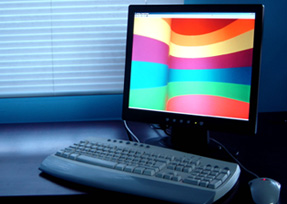Conserving energy used by the monitor:
Computer monitors should be set to switch off after 20 minutes of inactivity. A computer monitor consumes two-thirds of the electricity consumed by the computer as a whole. The hard disk should be set to turn off ten minutes later, after it has been inactive for 30 minutes. It is recommended that desktops and laptops be set to enter their standby mode if they have been inactive for 90 minutes. Computers using older systems such as Windows NT will not be privy to this feature and users will have to manually turn off the computer monitor whenever they leave their desk. Operating systems such as Windows XP have built in energy saving options, which should be turned on to save energy.
If you do not expect to be back at your desk for two hours, it is wise to switch off the computer and peripherals at the plug point. In the same way when entering the room in the morning, refrain from turning the computer on until you need to use it.
Why using a screen saver does not save energy:
A common mistaken belief is that by using screen savers one saves on energy consumption. In reality, screen savers were devised for older computers that had a problem of having an image being burnt on the screen. Today’s monitors no longer face that problem and for energy saving purposes, they should not have a screensaver set. Instead the machine should automatically go into standby mode after a fixed time. A 17-inch monitor on average consumes 66 watts of power when it is being used
Waking computers up:
Today software is available that will automatically switch off computers at a specified time in the night and can turn them back on in the morning. This prevents computers from being left on accidentally. Older computers sometimes experienced a drop in network performance when computers went on standby. If such a problem does occur, it would be advisable to enable energy saving settings on the monitor alone. New computers do not have any problems entering or waking up from an energy saving standby mode.
Unplugging computers at the end of the day:
Computers and their monitors should be turned off and unplugged during the night and on weekends. In order to make this easy, plug in all power cords onto an extension board or a UPS, this allows you to turn off all sockets with the flick of one switch.










